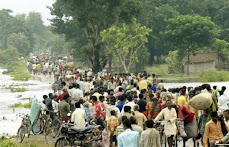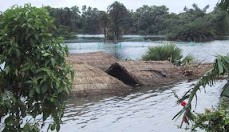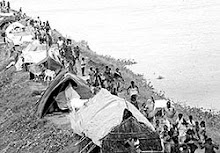Preliminary findings of the Fact Finding Team
Nearly 73.06 per cent of the area of Bihar is prone to flooding. It is estimated that about half a million have migrated from the embanked Kosi region alone. In the face of mass exodus from the state, the resumption of flood control embankments aggravates the situation of countrywide condemnation and humiliation that migrant Biharis face. These structures have compelled them to migrate in search of livelihood.
A multidisciplinary 14 member Fact Finding Team has concluded its 8 daylong travel of the flood affected regions of North Bihar wherein it traversed along the embanked parts of Kosi, Kamala, Bhutahi Balan and Baghmati rivers.
The visit from March 1-8, 2008, entailed visiting Khagaria, Saharsa, Supaul, Saptari, Kunauli, Kamalpur, Mahadeo Math, Nirmali, Ghoghardiha, Kosi barrage, Runni Saidpur, Sitamarhi, Vaishali and other places.
The manner in which floods have been amazingly sustained in this region despite over five decades of relentless efforts have been the core idea behind this voluntary mission.
Backed by volume of secondary literature but limited primary exposure of ground realities, this team is anguished to conclude that not only are these floods manmade but that the worse is yet to come should the political economy of flood control continue to pivot itself around `temporary embankment' as the only solution to the scourge of floods. The state pretends that it is afflicted by the colossal ignorance regarding the primary function of floodwater--draining out excess water and the fact that no embankment has yet been built or can be built in future that will not
breach.
The team is outraged to report that the government's investment of over Rs 1600 crores since the early 1950's has helped increase the flood prone area from 25 lakh hectare during the pre-plan era to over 68.8 lakh hectare today, an unprecedented three-fold increase. Proposed as temporary measure to control floods in the 1950s and having had failed on all fronts, the team is bewildered to note that the business of embankment construction has resumed after a lapse of 17 years with a Rs 792 crores package to tame the Bagmati. There is another proposal to embank the tributaries of Mahananda at
an estimated cost of Rs 850 crores. Clearly, the lessons in human misery
have not been learnt.
That over 2 million people are permanently trapped between the flood control
embankments and an equal number of people faced with acute water logging in the so-called flood protected areas, only exposes the stark failure of the state's democratic governance. The team observed the inevitability of migration due to loss of livelihood that is a consequence of state's benign intervention and its callousness. This exposes the migrant Bihari population to the wrath of perverted political monsters in Assam, Maharasthra, Punjab, and Delhi. Sporadic incidents across the country demonstrate state's collusive inaction. The team is astounded to observe that the state remains a mute spectator to the denial of basic rights of livelihood and instead it accentuates their misery by pretending ignorance about the outdated, tried, tested and failed technology of embankments as if it is caught in a time
warp.
The team observed state's arrogance and misplaced faith in engineering that has stopped the natural process of `landbuilding' by these rivers, a process that had ushered in necessary socio-cultural conditions for emergence of `civilisation'. Need it be said that the marriage of natural capital and social capital had made Bihar the apex knowledge center. The total collapse of this knowledge culture within the state is a result of embankment of this capital.
The team notes that 8.36 lakh hectare of land in North Bihar is permanently
waterlogged, which is nearly 16 per cent of the North Bihar's total area. Some 8 million people have been directly hit by water logging, earning the state the dubious distinction of being the leading claimant of this kind of manmade submergence. Draining vast stretches of waterlogged land is technologically and financially unfeasible. Can any welfare state afford to keep its most fertile lands under water?
The team witnessed how the poor and the powerless are obviously the main victims. It emerged from the narratives of the villagers that embankments are for the benefit of the contractor politicians and the technocratic development ideology to deal with flood suits them unmindful of the environmental and social mess.
As the embankment lobby has gained momentum once again, the fact that such interventions will raise river levels by several meters, making the land between the embankments uninhabitable for millions of people displacing them for good. The bitter experience of flood control embankments has given birth to a strong sentiment against it.
The team shockingly wondered about the land use change that has adversely affected the ecosystem of the region contributing to the rupture of its carrying capacity. It makes a classic case requiring urgent measures to undo the damages that appear beyond redemption.
The team examined the impact of flood control measures and the trends in consequent losses in the region. The team has inferred that migration is an indicator of the enormity of glaring state failure. Embankments remain the main loss-determining factor. The team calls for a white paper on the impact of existing embankments.
Those living today in the flood-affected region are promised other ecologically disastrous projects like Barahkshethra Dam and Interlinking of Rivers is like proposing one catastrophe to solve another a la devil and the deep sea.
The observations made by the team are its preliminary findings. The final and detailed report of the Fact Finding Team would be shared in due course.
by
Dinesh Kumar Mishra, Sudhirendar Sharma & Gopal Krishna
Historically, floods and their control have never been a big issue in the Ganga-Brahmaputra basin, as it is today. Floods became a major issue after the British occupied India. When they examined the Ganga basin, they believed that if it could be made “flood-free”, they could levy a tax in return for such protection.
Wednesday, 12 March 2008
Subscribe to:
Post Comments (Atom)








1 comment:
A new book "The Raj Lives: India In Nepal" by Nepali journalist
Sanjay Upadhya has erred in noting that "The Kosi project
primarily benefited India, which received 97 per cent of the water.
India irrigated millions of hectares of land, resulting in tens of
billions of dollars' worth of annual production. Nepal ended up with
vast tracts of land under water."
The fact is that it primarily harmed India. Even a tour of the Kosi region
within Bihar can illustrate the harm. Had the Kosi project been indeed
beneficial, Biharis would not have chosen to migrate to other states in search
of the most menial of jobs?.
It is true that the injustice done is not on anyone�s agenda today but this
holds true for both Bihar as well Nepal.
If the author had the benefit of going through the findings of the
Fact Finding Team on Bihar flood that also visited Saptari, on Nepal side, one
is sure he would have assessed the benefits differently. The fact is that the
Ministers of India and Nepal did not take voice of their respective into
cognisance as result there is misery on both sides. The team also met the former
Irrigation Minister of Nepal (a contemporary of Lalit Narayan Mishra)who
corroborated that the project was a result of a financial assistance for
development of his region that was granted by his Indian counterparts.
Had Kosi project been beneficial to Bihar, likes of Parameshwar Kunwar, village
Tarahi would not have been arrested for participating in a black flag
demonstration against Dr Rajendra Prasad, the President of India in 1955 when he
had come to lay the foundation stone for the eastern Kosi embankment?. The
protest of some 15 to 20 thousand people did not yield any result. Many went to
jail several times. But to no avail.
The protesters knew that embankments would ruin their lives and it has done so.
Dr Dinesh Kumar Mishra, a member of the Fact Finding Team notes in an earlier
article "Refugees of the Kosi" published in Himal South Asian that four decades
ago, going against scientific wisdom, the dam builders of India decided to
construct embankments on the Kosi river in north Bihar. That has resulted in an
untold story of the misery of this decision made by faceless technocrats and
unthinking politicians.
He writes, "People like Parameshwar Kunwar had submitted a 20-page memorandum
against the Kosi Project in 1957 to Dr Shri Krishna Sinha, the chief minister of
Bihar. The rejoinder came from T.P. Singh, Administrator of the Kosi Project in
English."
This ilk of bureaucrats and politicians still perpetuate the misery of the
people .
Post a Comment